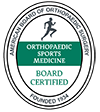Meniscal Tears
A meniscal tear is a tear that occurs in the cartilage of the knee. The meniscus is a small, "C" shaped piece of cartilage in the knee joint. Each knee has two menisci, the medial meniscus on the inner aspect of the knee and the lateral meniscus on the outer aspect of the knee. The medial and lateral menisci act as a cushion between the thigh bone (femur) and shin bone (tibia).
Meniscal tears are one of the most common injuries to the knee joint. They can occur at any age, but are more common in athletes playing contact sports.
Types
The different types of meniscal tears are categorized according to the location and extent of the tear. These include:
Frayed edge: In this type, the inner rim of the meniscus has a ragged appearance.
Radial tear: This type of tear occurs as a sharp split which starts along the inner edge of the meniscus extending towards the lateral rim.
Parrot-beak tear: This is an oblique tear of the inner rim of the meniscus which appears curved like a parrot's beak.
Circumferential tear (Longitudinal tear): This is a tear that occurs along the length of the meniscus.
Bucket-handle tear: This is a tear that goes all the way through the full depth of the meniscus. The handle portion of this type of tear may displace into the rounded end of the thigh bone, where it may cause locking of the knee joint and pain.
Horizontal cleavage tear: This type of tear starts after a minor injury as a horizontal split deep in your meniscus which is followed by degenerative changes in the area of damage. Eventually, the meniscus divides into top and bottom sections.
Flap tear: This type of tear occurs on the surface of the meniscus and creates a flap that moves.
Causes
The meniscus can tear following a twisting type of injury during sports or when getting out of a chair or standing up from a squatting position. Athletes can tear their meniscus by either a twisting motion, over flexing the knee joint, pivoting, or sudden stopping or deceleration. In athletes, meniscal tears often occur along with other injuries such as a torn anterior cruciate ligament (ACL).
Also as we age, our cartilage becomes a little more brittle and can therefore tear more easily.
Symptoms
The symptoms of a meniscal tear include:
- Pain over the inner or outer side of the knee, where the tear occurred
- A "popping"or "clicking" may be felt at the time of injury
- Catching or locking of the knee joint may occur if the torn cartilage gets caught between the femur and tibia
- Stiffness and swelling of the knee
- Inability to move your knee through its complete range of motion
- Sensation of your knee "giving way"
Diagnosis
To diagnose a meniscal tear your physician will take a detailed medical history and perform a physical examination of your knee.
The McMurray test is one of the important tests for diagnosing meniscal tears. During this test, the knee is bent, then straightened and rotated. These movements create pressure on a torn meniscus and any clicking sound during this test may suggest a meniscal tear.
Your doctor may order an X-ray of the knee to rule out osteoarthritis or other possible causes of your knee pain. Sometimes your doctor may order an MRI scan to obtain a better view of the menisci and assess the extent of injury.
Treatment
Initial treatment after the injury usually includes the RICE protocal: rest, ice, compression, and elevation to control the pain and swelling. Further treatment options will depend upon the type, location, and extent of the tear. Small tears can be treated conservatively with anti-inflammatory medications and physical therapy to strengthen muscles around the knee and prevent joint instability. A knee brace may be needed to immobilize your knee. You may need to walk with crutches temporarily to assist in limiting weight bearing.
Surgical treatment
If symptoms still persist after conservative treatment, your doctor may suggest surgery to repair the torn meniscus. Surgical treatment options include:
Meniscal repair: This procedure repairs the torn meniscus and restores the normal anatomy of the knee. However, this may not be able to treat tears located in an avascular part of the meniscus that lack a blood supply.
Meniscectomy: In this minimally invasive procedure the torn portion of the menisci is removed arthroscopically through tiny incisions with the aid of an arthroscope, a thin flexible scope with a video camera on the end to view internal structures.
Risks and Complications
As with any major surgical procedure, there are certain potential risks and complications involved with meniscus surgery. Possible risks and complications associated with meniscus surgery include:

- Infection
- Blood clots(Deep vein thrombosis)
- Nerve and blood vessel damage
- Ligament injuries
- Hemarthrosis (bleeding inside a joint)
- Arthrofibrosis (thick fibrous material around the joint)










